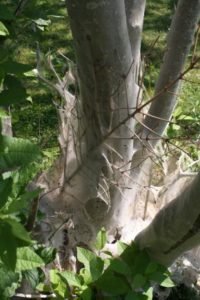
By USAG Stuttgart Public Affairs Office
As summer kicks off, the Oak Processionary Moth caterpillar has made its yearly appearance on some U.S. Army Garrison Stuttgart installations. This hairy caterpillar is common to central and southern Europe and may be hazardous to your health. Taking a few precautions, however, can greatly reduce any risk of irritation or other problems.
Hairs from the Oak Processionary Moth caterpillar contain thaumetopoein, a toxin that may cause a rash or, if inhaled, exacerbate asthma, according to officials at the U.S. Army Public Health Command Region-Europe.
Oak Processionary caterpillars, found in oak trees from May through July, typically follow one another head-to-tail in long “processions” to and from their nest, and from one feeding position to another.
Contact with the caterpillar’s fine hairs can irritate one’s lungs, eyes and skin, and in some cases, can cause severe allergic reactions.
The most common symptoms are the itchy rash and dermatitis, an inflammatory skin condition.
If the caterpillar hairs come in contact with eyes or mouth, a person may develop conjunctivitis (red eyes, sticky discharge, and inflammation of the eye) and/or irritation to the throat/airway. Itching typically begins two to 12 hours after exposure, and the rash may be widely spread over the entire body.
The best way to prevent an Oak Processionary caterpillar rash is to avoid the insects by following these tips:
• Do not touch caterpillars or nests.
• Do not try to remove nests by yourself.
• Do not play/picnic/walk under oak trees during peak infestation months.
• When participating in outdoor activities, wear long pants and long-sleeved shirts and a hat.
• Keep children away from caterpillars and nests.
• If you are exposed to the oak caterpillar hairs, take a shower and wash your clothes immediately.
• Consult a physician in case of severe exposure.
If you experience rash-like symptoms or itching and over-the-counter remedies are not working, see a health care provider.
Members of USAG Stuttgart’s Department of Public Works are undertaking efforts to locate and deal with populations of these caterpillars to minimize their impact on the community.
All Child, Youth and School Age Services facilities have been checked, and are clear.
Frequently Asked Questions:
Who is affected by these caterpillars?
The caterpillars’ hairs can affect anyone, but asthmatics in particular are at risk of having an attack. The hairs can also affect animals, including dogs, cats and horses, so people are also encouraged to keep their pets and livestock away from infested trees.
Why do these moths cause health problems?
Health problems are most common when the caterpillar is in its last stages of development in late May and early June, before becoming a moth. This is because the caterpillars are covered with tiny hairs that contain a toxin (thaumetopoein or closely related compounds). If these hairs and toxins come into contact with the skin they can cause symptoms.
What sort of symptoms do they cause?
If the hairs or toxins come into contact with the skin they can cause a very itchy skin rash. If they come into contact with the eyes they can cause itchy eyes. If symptoms are severe, consult a physician.
Can the symptoms be serious?
People vary in their response – not everyone reacts to the caterpillar hairs. The most common problem is an itchy rash which is unpleasant but not dangerous.
What should I do if I develop these symptoms?
If you are concerned about these symptoms you should contact the Health Clinic for advice.
Is there any treatment?
Treatment involves managing the rash caused by the hairs and the toxins and this could involve using an antihistamine cream to relieve the itching. Future exposure should be avoided to ensure symptoms do not return.
What should I do if I see a nest?
Anyone who thinks they have found oak processionary caterpillars or their nests should not touch them or attempt to remove them, but should report their sightings to the DPW Environmental Division giving as precise details as possible about the location. Digital photos sent with emailed sighting reports can help experts to confirm the sighting. For more information, contact Chief DPW Environmental Division at DSN 421 6131/ civ. 0711-722-86131.
